

How and Why Using Electronic Devices at Night Can Interfere With Sleep. Ninety percent of people in the U.S. admit to using a technological device during the hour before turning in, and children often use electronic media to help them relax at night.

If you’re among these nighttime technology-users, you may not realize the extent to which this can make it harder to settle down to sleep. But it can. The truth is, using electronic devices before bedtime can be physiologically and psychologically stimulating in ways that can adversely affect your sleep. Here’s what happens: Using TVs, tablets, smartphones, laptops, or other electronic devices before bed delays your body’s internal clock (a.k.a., your circadian rhythm), suppresses the release of the sleep-inducing hormone melatonin, and makes it more difficult to fall asleep.
This is largely due to the short-wavelength, artificial blue light that’s emitted by these devices. All of this is true for kids and adults alike. One good substitution is reading. Sleep for Teenagers - National Sleep Foundation. Sleep is food for the brain.
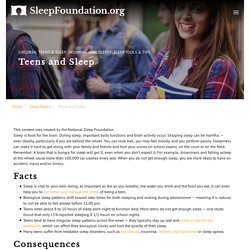
During sleep, important body functions and brain activity occur. Skipping sleep can be harmful — even deadly, particularly if you are behind the wheel. You can look bad, you may feel moody, and you perform poorly. Sleepiness can make it hard to get along with your family and friends and hurt your scores on school exams, on the court or on the field. Remember: A brain that is hungry for sleep will get it, even when you don’t expect it. Facts. Understanding Sleep Cycles. Before the 1950's, scientists used to believe that as people drifted off to sleep, their brains and bodies would go into “shutdown” mode, entering a passive state that allowed them to recover from the previous day.
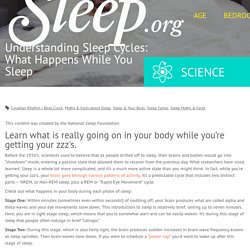
What researchers have since learned: Sleep is a whole lot more complicated, and it’s a much more active state than you might think. In fact, while you're getting your zzz's, your brain goes through various patterns of activity. It’s a predictable cycle that includes two distinct parts – NREM, or Non-REM sleep, plus a REM or “Rapid Eye Movement” cycle. How Sleep Cycle Works - Types & Stages of Sleep Cycle. It has been known that sleep goes in cycles since as early as 1937, and the distinction between REM and non-REM sleep was established in 1953.
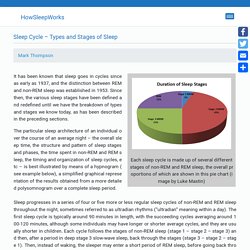
Since then, the various sleep stages have been defined and redefined until we have the breakdown of types and stages we know today, as has been described in the preceding sections. What Happens When You Sleep? - National Sleep Foundation. When we sleep well, we wake up feeling refreshed and alert for our daily activities.
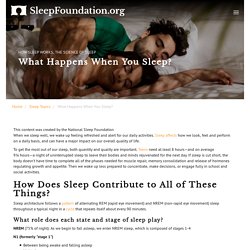
Sleep affects how we look, feel and perform on a daily basis, and can have a major impact on our overall quality of life. To get the most out of our sleep, both quantity and quality are important. Teens need at least 8 hours—and on average 9¼ hours—a night of uninterrupted sleep to leave their bodies and minds rejuvenated for the next day. If sleep is cut short, the body doesn’t have time to complete all of the phases needed for muscle repair, memory consolidation and release of hormones regulating growth and appetite. Then we wake up less prepared to concentrate, make decisions, or engage fully in school and social activities. Sleep architecture follows a pattern of alternating REM (rapid eye movement) and NREM (non-rapid eye movement) sleep throughout a typical night in a cycle that repeats itself about every 90 minutes.
Brain Basics: Understanding Sleep. Sleep 101 Basics: REM, NREM, Sleep Stages, & More. The maturational trajectories of NREM and REM sleep durations differ across adolescence on both school-night and extended sleep. Sleep cycle. Sample hypnogram showing one sleep cycle (the first of the night) from NREM through REM The sleep cycle is an oscillation between the slow-wave and REM (paradoxical) phases of sleep.
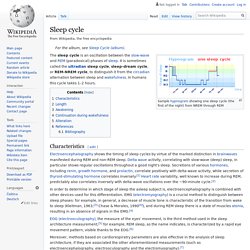
It is sometimes called the ultradian sleep cycle, sleep–dream cycle, or REM-NREM cycle, to distinguish it from the circadian alternation between sleep and wakefulness. In humans this cycle takes 1–2 hours. Characteristics[edit] The Sneaky Ways That Blue Light Can Interfere With Your Kids’ Sleep. As difficult as it is to get kids to stop watching TV or using their electronic devices before bedtime, there’s a compelling reason to make it happen.
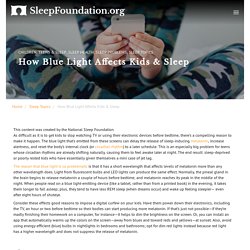
The blue light that’s emitted from these screens can delay the release of sleep-inducing melatonin, increase alertness, and reset the body’s internal clock (or circadian rhythm) to a later schedule. This is an especially big problem for teens whose circadian rhythms are already shifting naturally, causing them to feel awake later at night. The end result: sleep-deprived or poorly rested kids who have essentially given themselves a mini case of jet lag.
The reason that blue light is so problematic is that it has a short wavelength that affects levels of melatonin more than any other wavelength does. Light from fluorescent bulbs and LED lights can produce the same effect. Consider these effects good reasons to impose a digital curfew on your kids. How Much Deep Sleep Do You Need? If you are getting the recommended amount of slumber — seven to nine hours a night — you’re spending about one-third of your life asleep.
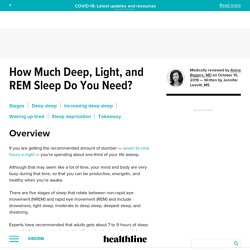
Although that may seem like a lot of time, your mind and body are very busy during that time, so that you can be productive, energetic, and healthy when you’re awake. There are five stages of sleep that rotate between non-rapid eye movement (NREM) and rapid eye movement (REM) and include drowsiness, light sleep, moderate to deep sleep, deepest sleep, and dreaming. Experts have recommended that adults gets about 7 to 9 hours of sleep per night. New research aims to identify not just how much total sleep you need — but also how much of each stage of sleep you need. Sleep stages 1, 2, and REM consist of light sleep, while 3 and 4 comprise deep sleep. Stage 1 During stage 1, you drift from being awake to being asleep. Stage 2. The Science of Sleep. Your internal clock (circadian rhythms) Certain brain structures and chemicals produce the states of sleeping and waking.
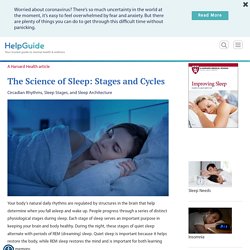
For instance, a pacemaker-like mechanism in the brain regulates circadian rhythms. (“Circadian” means “about a day.”) This internal clock, which gradually becomes established during the first months of life, controls the daily ups and downs of biological patterns, including body temperature, blood pressure, and the release of hormones. Circadian rhythms make people’s desire for sleep strongest between midnight and dawn, and to a lesser extent in mid-afternoon. Most Americans sleep during the night as dictated by their circadian rhythms, although many who work on weekdays nap in the afternoon on the weekends. Light. Sleep Cycle - Steiger - - Major Reference Works. 0022 3956 2874 2990011 920170201 14123 1rjq478. The Characteristics of Sleep. What Is Sleep?
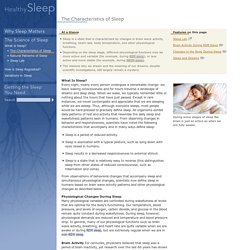
Every night, nearly every person undergoes a remarkable change: we leave waking consciousness and for hours traverse a landscape of dreams and deep sleep. When we wake, we typically remember little or nothing about the hours that have just passed. Except in rare instances, we never contemplate and appreciate that we are sleeping while we are asleep. Thus, although everyone sleeps, most people would be hard-pressed to precisely define sleep. All organisms exhibit daily patterns of rest and activity that resemble the daily sleep and wakefulness patterns seen in humans. Sleep is a period of reduced activity.Sleep is associated with a typical posture, such as lying down with eyes closed in humans.Sleep results in a decreased responsiveness to external stimuli.Sleep is a state that is relatively easy to reverse (this distinguishes sleep from other states of reduced consciousness, such as hibernation and coma).
Changes in Sleep with Age. A Life of Change Over a typical lifespan, the amount of time we spend each day sleeping declines. Newborns spend from 16 to 20 hours asleep each day. Between the ages of one and four, total daily sleep time decreases to about 11 or 12 hours. This gradual decline continues through childhood, such that an adolescent will need—though not necessarily get—about nine hours of sleep to function at his or her best.
Adults through middle age need at least eight hours, and although the elderly may still require up to eight hours, they may struggle to obtain those hours in one block. Sleep in Adolescents. What to expect Adolescents are notorious for not getting enough sleep. The average amount of sleep that teenagers get is between 7 and 7 ¼ hours. However, they need between 9 and 9 ½ hours (studies show that most teenagers need exactly 9 ¼ hours of sleep). Stages of Sleep - Non-REM and REM Sleep Cycles. Written by - Jocelyn Zakri MPH, RRT, RPSGT, RST. Last updated March 5, 2020 Overview Usually sleepers pass through four stages: 1, 2, 3, and REM (rapid eye movement) sleep.
These stages progress cyclically from 1 through REM then begin again with stage 1. A complete sleep cycle takes an average of 90 to 110 minutes, with each stage lasting between 5 to 15 minutes. How Sleep Cycle works - Sleep Cycle alarm clock. Waking up easy is all about timing. How Does Sleep Work? What is REM Sleep? - ResSleep. It’s easy to think that sleep is just one long period of unconsciousness that we go through each night. We get into bed, close our eyes and drift off, only to wake the following morning.
Psychology Today Australia. Source: Stock-Asso/Shutterstock. 4 Alternative Sleeping Cycles That You Didn't Know About [infographic] Around the world, there’s one thing people seem to agree on – that we go to sleep at night and stay awake in the day. But science proves that other sleeping patterns are feasible, and possibly more preferable. Follow the law of contrary public opinion and try one of these alternative sleeping cycles. Natural Patterns of Sleep. Waking up to Sleep Our bodies require sleep in order to maintain proper function and health.